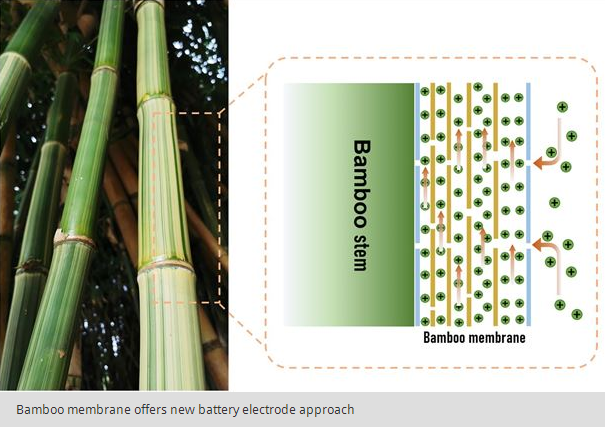Scientists from Queensland University of Technology have developed a new way to boost the efficiency of batteries with electrodes that can be recharged at a much faster rate based on the unique properties of bamboo. The study, which furthers research into 2D nanomaterials for the very fast transport of ions through a battery, was inspired by a water-carrying membrane inside bamboo that allows it to be the fastest growing plant in the world. The lab of Ziqi Sun has been studying how best to mimic the structural and optical properties of natural objects – such as seashells that have inspired advanced optical thin films, fish scales that have inspired multifunctional nano-coatings – to develop sustainable energy solutions from low-dimensional nanomaterials. This breakthrough was inspired by investigating the multi-layer membrane that runs inside the bamboo stem, which has very closely packed layers on the side closest to the inner ring of the bamboo, and further apart layers on the side nearest the center. This structure allows for extremely fast movement of water and nutrition up the bamboo to support its rapid growth rate. As detailed in Advanced Functional Materials [Mei et al. Adv. Funct. Mater. (2021) DOI: 10.1002/adfm.202100299], a membrane was fabricated that mimicked this structure from layers of nanosheets of cobalt oxides and graphene, with suction being applied to one side of the sheets. The interlayer spacing of the resulting membrane is controlled by the pressure drop from the increase in membrane thickness to realize accurate control of the spacings. On testing for its ability to move ions through lithium-ion batteries, the multi-level 2D thin films outperformed other materials typically used for battery electrodes, bringing the fast diffusion of electrolyte and ion/charge transport via the well-confined nanofluidic interlayers. This transport of charges and carriers controls the material and device performance. On investigating the membrane’s wettability, the ability of liquid to maintain contact with a solid surface, the membranes showed a superwetting behaviour towards organic electrolyte, so there was no barrier for the contact and entry of the electrolyte from the surface into the membrane. This furthers our understanding of 2D-based electrodes that can allow both the fast surface permeation and the interlayer ultrafast ion transport through the design of multi-level channels. As Sun said, “The study offers a new principle in designing high-performance energy materials. Most importantly, it paves a way for future materials intervention by learning from the greatness of nature.” The simple and controllable fabrication method could be adapted for the industrial scale and inexpensive production of multi-level 2D electrode membranes, such as high-performance electrodes for energy, including rechargeable batteries and supercapacitors. The team now hope to further tailor the interlayer to optimize its structure and performance, and perhaps expand the concept to other 2D materials. (Laurie Donaldson)
Source from: https://www.materialstoday.com/electronic-properties/news/bamboo-inspires-faster-battery-recharging/
|


_1.jpg)

